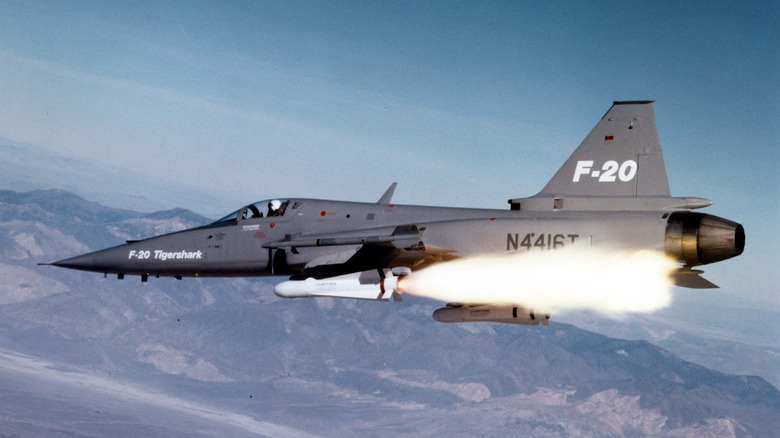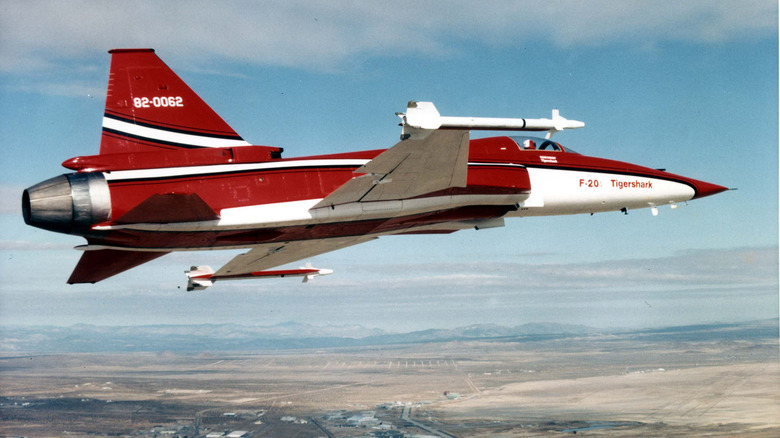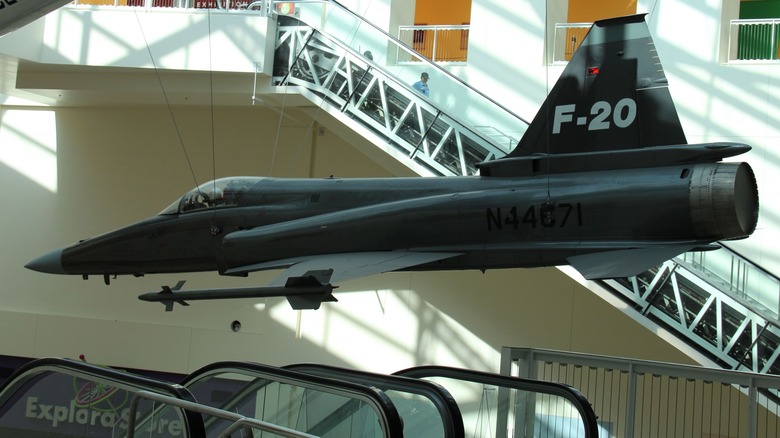Everything To Know About The F-20 Tigershark Fighter Jet
Looking at the F-20 Tigershark, it's hard to believe this sleek fighter jet is almost half a century old. Indeed, it was cutting-edge for its time, and it took creator Northrop over seven years to develop before it was ready for the skies. But for all that advanced tech, the F-20 Tigershark was never mass-produced. And when Northrop released the world's most (ironically) recognizable stealth bombers like the Grumman B-2 Spirit, their lightweight, low-cost aircraft designs lost the spotlight.
The F-20 Tigershark deserves its due recognition. Although it never saw much development beyond its prototype, it was nonetheless a ground-breaking design that set the stage for a new era of low-cost, highly reliable, and extremely fast aircraft. Without the competitive incentives from Northrop's innovations, famous fighters like the F-16 might have followed a different storyline.
So why did such a brilliant aircraft fail to see mass production? The answer is complex, but it starts with the political climate at the time of its release in 1982. Furthermore, its specs are impressive even today, yet they weren't enough to overcome the fierce competition from USAF-funded companies like General Dynamics nor the waning public support for fancy weapons of war. The final nail in the coffin was the tragic death of test pilot Darrell Cornell while demonstrating the F-20A variant in 1984. The late pilot blacked out from the high G-force during an acrobatic maneuver, and the future of the F-20 aircraft came crashing down.
The impressive specs of the F-20 Tigershark
Development of the F-20 Tigershark began in 1975. Northrop invested its own research funding into designing and building the aircraft, intending to sell it on international markets once released. According to Northrop's promotional ads of the time, now conserved in the California Science Center, it was, "1 ½-times as reliable as its closest competitor... requires less support equipment and only half the maintenance personnel." Indeed, its major selling point was the low cost of assembly and maintenance, but its other specs are just as attractive.
With a 28-foot wingspan, the F-20 Tigershark was narrow enough to fall into the "light aircraft" category. This light aerodynamic build helped it reach a maximum climbing speed of 53,000 ft/min, and it needed only 1,475 feet of tarmac to take off. Once in the sky, this supersonic jet could hit Mach 2. Had its production not been scrapped, it may have made it onto the list of the most impressive supersonic bombers of all time.
The greatest advancement of the F-20 Tigershark was its GE F404 engine. This beast of an engine used the latest afterburning engineering to generate 40-60% more thrust compared to the Tigershark's predecessor, the F-5E Tiger II. And that's considering the combined thrust of both the Tiger II's twin engines, while the Tigershark used just the one. Needless to say, this thing was fast.
The brief history of the F-20 Tigershark: A life cut short by competition
Only one F-20 prototype remains. It hangs from the ceiling of the California Science Center as proof that innovative technology can fail to sell. It was an extremely reliable and practical design. But history is indifferent to the designs of mice and men. The F-20 was conceived in 1975 at the height of the Cold War. Big companies like General Dynamics (now Lockheed Martin) and Northrop (now Northrop Grumman) were vying for U.S. contracts to build fighter jets. Billions were pumped into creating aircraft to compete with Soviet planes, like the legendary Sukhoi Su-27.
But when Northrop sought to create a light fighter with high speeds and low costs, it funded the project with its own money. Such a plane would have high demand on international markets since countries like Taiwan and South Korea were buying western aircraft in droves. One year before the F-20 was ready for liftoff, however, Reagan was elected president in 1981, and US foreign policy changed virtually overnight.
The biggest blow was the 1982 U.S.-PRC Joint Communiqué, which blocked the sale of arms to many of China's rivals, including Taiwan. As a result, Northrop had to shift its sites to the domestic market. Now, the self-funded F-20 project was looking like a poor investment. The F-16 Fighting Falcon was already the darling of the USAF by 1978. Reading the writing on the wall, Northrop canceled further development of the F-20 after producing only three prototypes.
Thus, the fate of the F-20 Tigershark, with all its potential, is a museum display.


